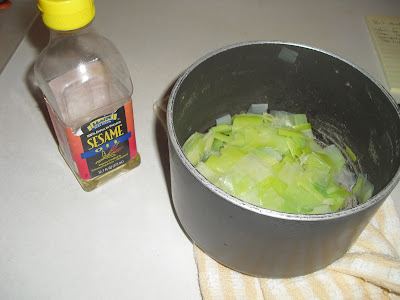What do you get when you mix heavy-duty monastery prayer, clergy who thought themselves too ascetic for "fine white" bread, and an environment where ale is always available?
Cloister Barely Bread.
It sticks to your bones, people. Want fiber? Check.
Whole grains? Check.
Whole grains? Check.
A bread that a few bites will take you ten minutes to chew? Check.
Look at all those chewy whole-grains. There they are, just begging to keep you regular.
Here are the culprits, my friends. Strong whole wheat flour (the recipe called for "wholemeal", whole wheat is similar), barley (anxiously waiting to be ground), rice flour, active dry yeast, honey, a good brown ale, salt, and some warm water.
Guaranteed to help you avoid sinning.
Maybe.
Now, if you want to get really fancy, you can grind your own barley. I did, but I cheated and used a coffee grinder. I'm fairly certain the monks would have looked down on me for this.
Result: 225 grams of scrumptious ground barley flour.
Next, mix together the dry ingredients in a large bowl. Enjoy the smell of fresh flour.
Mix the ale and yeast together until they form a nice cream.
(Monks love ale. Yeast loves ale. Happiness abounds)
Then mix with 1 1/2 cups of the warm water and honey.
Stir the wet mixture into the dry goods and mix to form a firm dough (this will be very sticky) and add extra water as needed. I found that the 1 1/2 cups was more than enough. Knead until the dough feels elastic and thoroughly mixed. Cue the large bowl.
Shape into a ball.
Shape into a ball.
Lift the dough out of the bowl, oil the inside of the bowl, and replace the dough. Cover with a damp cloth and let rise for about an hour in a warm place. I like to boil a pan of water, place it in a cold oven, and then add the covered dough. The steam from the pan allows for a warm happy environment for rising.
Punch the dough down and shape into two round loaves. Place in two baking pans (I used 9 inch cake pans). Use some extra whole wheat flour and sprinkle the top. Then, for extra authenticity, make criss-cross slits on the top of each. Re-cover and let rise.
Preheat the oven to 450 °F. When heated, take the now twice-risen dough and place in the oven for 20-25 minutes. If done, they should sound hollow when tapped on the bottom.
Let cool on a wire rack and cut when cool.
Enjoy your healthy prayer-sustaining loaves and allow extra time for thorough chewing.
Barley Bread
from: Maggie Black, The Medieval Cookbook (New York: Thames and Hudson, 1992), 55-56.
Ingredients
500 g strong wholemeal flour
225 g barley flour
25 g rice flour
1/2 tablespoon salt
1/2 oz/2 packets fresh yeast
1/3 cup brown ale
2 cups warm water
2 teaspoons clear honey
Preparation Instructions
Mix the dry ingredients in a warmed bowl. Blend the yeast to a cream with a little ale, then mix with 1 1/2 cups of the water and honey. Stir mixture into the dry goods and mix to a firm dough, adding extra water as needed. Knead until the dough feels elastic. Shape it into a ball. Lift it out of the bowl and oil the inside of the bowl lightly. Return the dough, cover it loosely with oiled polythene and leave the bowl in a warm place until the dough has almost double in bulk. Punch it down, then shape it into two equal-sized oblong or round loaves. Place in two bread or deep cake tins. (For traditional round loaves, use deep cake tins with removable bases.) Make a cross-cut in the centre of round loaves. Pre-heat the oven to 450 degrees F.
Cover the dough lightly with a cloth and leave in a warm place until well risen. Bake the loaves for 20-25 minutes; they should sound hollow when turned out and tapped underneath. If they need a few minutes longer, cover them lightly with greased foil and lower the oven heat slightly. Cool them under a cloth, on a wire rack. Do not cut until quite cold.

















































